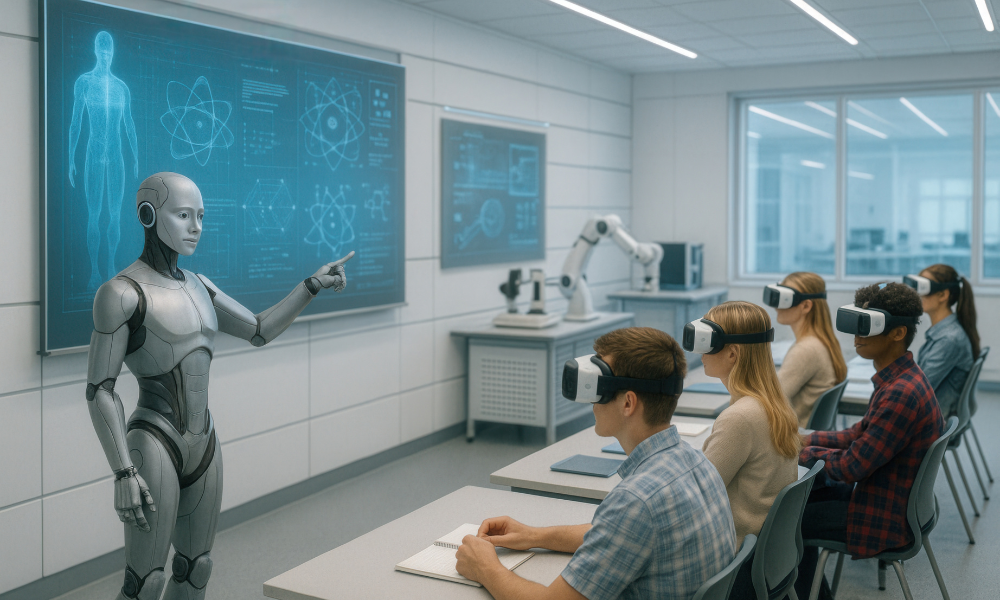A Beginner’s Guide to Neural Networks: From Perceptrons to Deep Learning
Artificial Intelligence (AI) is transforming how machines learn and make decisions, and at the core of this revolution lies neural networks. Inspired by the human brain, neural networks power everything from voice assistants like Siri to recommendation systems on Netflix. This beginner’s guide will take you on a journey through the fascinating world of neural networks — from the humble perceptron to the complex architectures of deep learning.
- What Are Neural Networks?
A neural network is a computational model designed to recognize patterns. It mimics how neurons in the human brain work — taking inputs, processing them, and generating outputs. In simple terms, it’s a system of algorithms that helps computers learn relationships between data and make predictions.
Neural networks are the backbone of machine learning and deep learning. They excel at solving problems that are hard to program manually — like image recognition, speech processing, and natural language understanding.
- The Building Block: Perceptron
The journey of neural networks began with the perceptron, introduced by Frank Rosenblatt in 1958.
A perceptron is the simplest type of artificial neuron and forms the foundation of modern neural networks.
It consists of:
- Inputs:The features or data points.
- Weights:Parameters that determine the importance of each input.
- Summation Function:Adds up the weighted inputs.
- Activation Function:Determines if the neuron “fires” (outputs 1) or not (outputs 0).
Example:
Imagine you want to train a perceptron to identify whether an email is spam.
Inputs might include words like “free,” “offer,” or “click.” Each word has a weight based on how likely it indicates spam. The perceptron adds them up and makes a binary decision.
Although powerful, perceptrons could only solve linearly separable problems (e.g., simple yes/no decisions). They failed with complex data like images or text — leading to the AI winter in the 1970s.
- The Rise of Multilayer Neural Networks
In the 1980s, researchers discovered that adding multiple layers of neurons could help solve non-linear problems.
This innovation gave birth to the Multilayer Perceptron (MLP) — a network with:
- Input Layer:Receives data.
- Hidden Layers:Extract features and learn relationships.
- Output Layer:Produces the final prediction.
Using backpropagation (an algorithm for training neural networks), these models learned from errors and adjusted weights automatically.
This breakthrough reignited interest in AI and led to modern deep learning.
- Understanding Activation Functions
Activation functions determine the output of each neuron and introduce non-linearity into the network. Common types include:
Activation Function | Description | Use Case |
Sigmoid | Outputs between 0 and 1 | Binary classification |
Tanh | Outputs between -1 and 1 | Normalized data |
ReLU (Rectified Linear Unit) | Outputs zero for negative values, linear for positives | Deep learning networks |
Softmax | Converts outputs into probabilities | Multi-class classification |
Without activation functions, neural networks would behave like linear models — losing their ability to learn complex data patterns.
- Deep Learning: The Modern Neural Network
Deep learning refers to neural networks with many hidden layers. These layers progressively extract higher-level features from raw data.
For instance:
- In image recognition, lower layers identify edges, while higher layers detect shapes or objects.
- In speech recognition, early layers detect frequencies, and deeper ones identify words or accents.
Popular deep learning architectures include:
- Convolutional Neural Networks (CNNs):Great for image and video processing.
- Recurrent Neural Networks (RNNs):Designed for sequential data like text or time series.
- Transformers:Powering modern AI tools like ChatGPT and BERT, they process language efficiently.
- How Neural Networks Learn
Training a neural network involves three key steps:
- Forward Propagation:Inputs move through the network to produce an output.
- Loss Calculation:The error (difference between predicted and actual value) is measured.
- Backward Propagation:The network adjusts its weights to minimize the loss.
Through multiple training cycles, or epochs, the network learns to make accurate predictions. The goal is to reach a balance where the model generalizes well to new data — avoiding overfitting (memorizing training data).
- Applications of Neural Networks
Neural networks are used in almost every field today:
- Healthcare:Diagnosing diseases, analyzing medical images.
- Finance:Fraud detection, stock market prediction.
- Transportation:Self-driving cars and route optimization.
- Marketing:Customer segmentation and recommendation systems.
- Natural Language Processing:Chatbots, translation, and sentiment analysis.
These applications demonstrate the adaptability and power of neural networks across industries.
- Challenges in Neural Networks
While neural networks are revolutionary, they also face challenges:
- Data Requirements:They need large datasets to learn effectively.
- Computation Power:Training deep models demands high-end GPUs.
- Interpretability:Understanding how networks make decisions can be complex.
- Bias and Ethics:Poorly trained models can reinforce existing biases in data.
Researchers are now focusing on Explainable AI (XAI) to make neural networks more transparent and trustworthy.
- The Future of Neural Networks
The future points toward smarter, more efficient models that require less data and compute power. Innovations like neural architecture search, quantum neural networks, and edge AI are paving the way for faster and more sustainable AI systems.
As AI continues to evolve, neural networks will remain the heart of intelligent computing — driving advancements in automation, robotics, and decision-making.
From simple perceptrons to advanced deep learning systems, neural networks have come a long way. They’ve transformed how machines interpret data and make decisions — pushing the boundaries of what’s possible with artificial intelligence.
Whether you’re an AI enthusiast, student, or professional, understanding neural networks is your first step into the exciting world of machine learning and deep learning.


